Brief introduction to Climate and altitude of Coffee Bean cultivation in Nicaragua

Nicaragua's Madagelba, Chinodega, Segovia region of coffee produced by coffee lovers respected the world. Especially the coffee from Madagalba, which tastes very similar to Kenya AA coffee.
Nicaragua is an economically backward agricultural country and one of the poorest countries in Central America. The unemployment rate is very high and the people live in poverty. Coffee is the pillar industry of Nicaragua, producing nearly 100,000 tons of coffee beans every year. Because of the poor economic base, the coffee industry is still relatively backward, and coffee farmers are also in a relatively poor state.
Although Nicaragua is a large country in Central America, it is not a big producer of coffee in the world. Compared with its neighbor Costa Rica, its production and reputation are much weaker. However, Nicaragua coffee of high quality ranks among the top coffee beans in the world and enjoys a reputation.
Dry aromas are rich in chocolate flavours, accompanied by hazelnut and cocoa aromas. The moist aroma also has chocolate flavours with orange peel aromas. Bright lemon fruit acids and a long cocoa finish are wonderful at the city+ roast.
Dry aroma (1-5): 3.8
Wet aroma (1-5): 3.8
Nicaragua is one of the world's leading coffee producers, producing coffee of high quality. Starbucks, a well-known coffee chain, also has cooperative coffee farmers in Nigeria. Nicaragua has a unique environment, it is located in central Central America, west Pacific Ocean, east Caribbean Sea. North central highlands, coastal plains to the east, is part of the Central American volcanic belt. The eastern plain is hot and rainy, and has a tropical marine climate. Fertile volcanic soil and hidden planting methods provide a good growing environment for coffee
Nicaragua coffee is one of the best in the world. It is mild and delicious, medium-sized and very aromatic. In many countries coffee production has been severely affected for political reasons. The coffee industry in Nicaragua is no exception. The revolution of 1979 forced coffee growers to flee to Miami. A period of uncertainty ensued as the government considered whether to reallocate land, including many plantations, resulting in a shortage of coffee supplies and a decline in production from more than 1 million bags in the early 1970s to less than 600,000 bags in 1990
The main export product of Nicaragua. Nicaragua's total coffee production for the 1998/99 coffee year could be 12 per cent lower than in 1997/98 due to the poor harvest in the Pacific region, according to the president of the Nicaraguan Coffee Farmers Federation. Nicaragua harvested a total of 1.422 million bags (46kg/bag) of coffee in the 1997/98 coffee year, the best harvest since coffee production hovered around 1 million bags for 14 years. Coffee exports are expected to be around 1.5 billion U.S. dollars in 1998. $600 million, Nicaragua coffee production will drop sharply @ Vechele coffee is Nicaragua's main export product. nicaragua's total coffee production for the 1998/99 coffee season may be 12 percent lower than in 1997/98 because of the poor harvest in the pacific region, according to the president of the Nicaragua coffee farmers federation
Nicaragua is now one of the poorest countries in Central America. Because of its poor economic base, the coffee industry is still in a relatively backward state, while coffee farmers are in an extremely poor state. Fortunately, Nicaragua's coffee has received some foreign aid funds to improve the quality of its coffee.
Important Notice :
前街咖啡 FrontStreet Coffee has moved to new addredd:
FrontStreet Coffee Address: 315,Donghua East Road,GuangZhou
Tel:020 38364473
- Prev

Silky and delicate Nicaragua coffee grind treatment Roast degree profile
In fact, coffee in Nigeria is known all over the world (Starbucks has many cooperative coffee farmers in Nigeria), and several coffee producing countries in Central America, Ex: Guatemala, Costa Rica, Nicaragua, produce coffee of similar quality, mainly due to differences in weather conditions, soil fertility, planting height, etc. Nigeria has a unique environment for coffee production
- Next

A brief introduction to the flavor, taste and aroma characteristics of Brazilian boutique coffee beans
Other kinds of Brazilian coffee, such as Rio and Parana, can be produced in large quantities because they do not need too much care. Although they taste rough, they can be regarded as a kind of good and cheap coffee. Because they are distributed all over Brazil and their solid quality varies, they have their own standards (NO.2~NO.8 according to the number of sundries, NO.13~NO.19 according to the size of beans, and six according to taste).
Related
- Detailed explanation of Jadeite planting Land in Panamanian Jadeite Manor introduction to the grading system of Jadeite competitive bidding, Red bid, Green bid and Rose Summer
- Story of Coffee planting in Brenka region of Costa Rica Stonehenge Manor anaerobic heavy honey treatment of flavor mouth
- What's on the barrel of Blue Mountain Coffee beans?
- Can American coffee also pull flowers? How to use hot American style to pull out a good-looking pattern?
- Can you make a cold extract with coffee beans? What is the right proportion for cold-extracted coffee formula?
- Indonesian PWN Gold Mandrine Coffee Origin Features Flavor How to Chong? Mandolin coffee is American.
- A brief introduction to the flavor characteristics of Brazilian yellow bourbon coffee beans
- What is the effect of different water quality on the flavor of cold-extracted coffee? What kind of water is best for brewing coffee?
- Why do you think of Rose Summer whenever you mention Panamanian coffee?
- Introduction to the characteristics of authentic blue mountain coffee bean producing areas? What is the CIB Coffee Authority in Jamaica?

